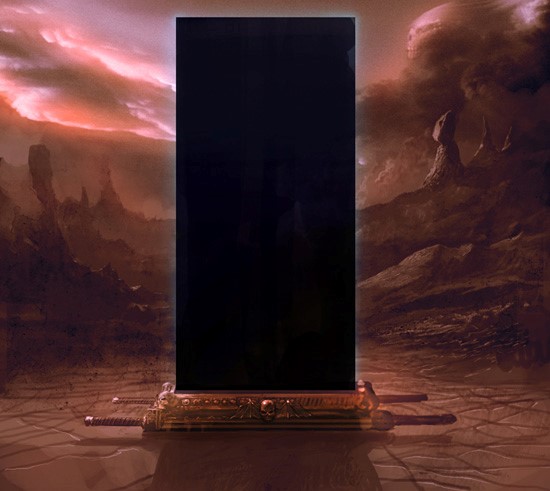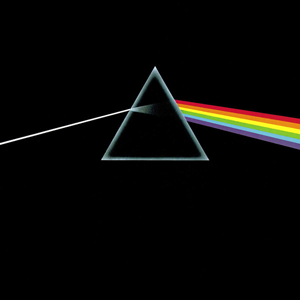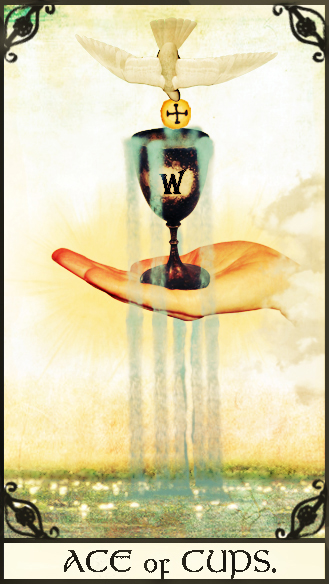
The Holy Grail story is familiar to many in the western world; to some it is an icon of literature and to others a source of comical amusement thanks to Monty Python and the Holy Grail. It is absolutely true that the Holy Grail represents the divine knowledge gained at the end of an inward spiritual journey—knowledge that is gradually lost through the cyclical ages that Hesiod, Vedic and even Hermetic traditions speak of.
Traditionally, it is a legend commencing in late 12th century, created by French and German poets like Wolfram von Eschenbach in Parzival. The Holy Grail takes various forms: a plate or bowl containing the bread of Holy Communion for the Fisher King. It is also portrayed as a stone cast down from heaven on which the abstaining angels stood for sanctuary when Lucifer rebelled against God as mentioned in texts like Isaiah and Ezekiel. The gem was given to Adam when he lived in the Garden of Eden after the rebellion of the angels. When he and Eve were cast out, the Grail was lost to him as well. Seth, Adam’s progeny, was said to have gained re-entry into Eden and to have recovered the sacred vessel. Significantly, Seth remained in paradise for 40 years. The number 40 is itself a mystical motif; Moses wandered for 40 years in the desert, with Noah on the ark 40 days and nights, for Jesus was tempted for 40 days.
It is also a cup in which Joseph of Arimathea collected Christ’s blood on the cross. More modern interpretations include Mary Magdalene as the receptacle of Jesus’ seed as the foundation for the “Merovingian bloodline,” as the authors of Holy Blood Holy Grail have theorized. The chalice is most popular today, doubling as the same cup used by Jesus in the Last Supper. Joseph of Arimathea is said to have brought the Grail to England, which then became an important part of the Arthurian myths.
The Holy Grail myth also links to ideas of gnosis in its relationship to humanity and the world, especially the world of nature and its elements. In the book Baphomet: The Mystery of the Temple Unveiled by Tracy Twyman and Alex Rivera, we go into a great explanation that the Holy Grail cup wasn’t just the vessel for the holy blood of Christ but was actually connected to the Krater of Hermes and the Ophite/Orphic Bowl of the coiled dragon-like serpent (please see our book for more details on this). It is also connected to the idol head that the Templars supposedly worshiped Author authors like Julius Evola, have argued for a non-Christian and even Hyperborean origin for the Grail legend, in his book The Mystery of the Grail, a possibility in which we will explore later in the second part of this post at a future point in time.
Julius Evola writes in the same book that there are certainly repeating patterns and archetypes that any student of Carl Jung would identify with clarity. It also ties into the mono-myth cycles of Joseph Campbell as we will see later:
When we isolate the texts that make up the Grail cycle, we find that they repeat a few essential themes, which are expressed through the symbolism of knightly figures and deeds. What we are dealing with, then, are essentially the themes of a mysterious center; of a quest and a spiritual test; of a regal succession or restoration, which sometimes assumes the character of a healing or avenging action. Percival, Gawain, Galahad, Ogier, Lancelot, and Peredur are essentially various names portraying the same human type; likewise, King Arthur, Joseph of Arimathea, Prester John, and the Fisher King are equivalent figures and variations on another theme. Also equivalent are images of various mysterious castles, islands, kingdoms, and inaccessible and adventurous lands, which in the narratives are described in a series that, on the one hand, creates a strange, surrealistic atmosphere but, on the other, often ends up becoming monotonous.
As the authors of Holy Blood Holy Grail have identified, the “divine blood” is an important concept and is one that repeats in the Bible, in both the Old and the New Testament as we will see. Evola further writes about all the objects associated with the Grail, especially of the blood:
In the various texts, the Grail is essentially portrayed under three forms:
“1. As an immaterial, self-moving object, of an indefinite and enigmatic nature (“it was not made of wood, nor of some metal, nor of stone, horn, or bone”).
- As a stone-a “heavenly stone” and a “stone of light.”
- As a cup, bowl or tray, often of gold and sometimes adorned with precious stones.
Both in this form and in the previous one, we almost always find women carrying the Grail (another element totally extraneous to any Christian ritual, since no priests appear in it). A mixed form is that of a cup carved out of a stone (sometimes of an emerald). The Grail is sometimes qualified as “holy;’ sometimes as “rich”; “this is the richest thing that any man hath living.”l This text, like many others of the same period, uses the expression “Sangreal;’ which is susceptible to three interpretations: Holy Grail, Royal Blood, and Regal Blood.”
Jack Curtis writes in The Quest for the Holy Grail, is essentially:
“… a system of self transformation that can be reconciled with other similar systems in the Western esoteric tradition. It is a cosmological scheme that is comparable with Tarot, Kabala and Astrology. There are also hints of a connection with Alchemy. All of these systems or schemes follow a unifying principle that points to one underlying reality. The Holy Grail in its 5 Transformations, is one approach to that reality. To achieve the Grail, is to understand reality. To understand reality, is to be transformed and to be saved.”
How does any of this tie into the blood of Jesus Christ? For that answer, we must look beyond the natural and the flesh. The blood is obviously symbolic in its spiritual meaning. It is the spiritual power behind the blood of Jesus in which the believer partakes in, and is eternally saved to be allowed to enter a place that is so radically different than the manifest world—being the “Kingdom of God.”
The Holy Blood
In Jesus’ death on the cross, we read that in John 19:32-38, especially verse 34:
32 So the soldiers came, and broke the legs of the first man and of the other who was crucified with Him; 33 but coming to Jesus, when they saw that He was already dead, they did not break His legs. 34 But one of the soldiers pierced His side with a spear, and immediately blood and water came out. 35 And he who has seen has testified, and his testimony is true; and he knows that he is telling the truth, so that you also may believe. 36 For these things came to pass to fulfill the Scripture, “Not a bone of Him shall be [a]broken.” “They shall look on Him whom they pierced.” 38 After these things Joseph of Arimathea, being a disciple of Jesus, but a secret one for fear of the Jews, asked Pilate that he might take away the body of Jesus; and Pilate granted permission. So he came and took away His body.
Note the extraordinary hiatus John introduces into the narrative at this point. Clearly he wants us to note something of supreme importance: the legend is that Joseph caught some of this blood and water in the chalice used for the last supper.
Eric Wargo in The Passion of Einstein: Light, Spacetime, and the Holy Grail, rightly points out:
I think we can really see the Grail as both objects simultaneously, and that its atemporal “absurdity” is essential to the salvific nature of Christ’s blood: How could the blood shed on the Cross have gotten into the cup of the Last Supper other than by having traveled back in time? Christ’s blood is either made of tachyons (hypothetical faster-than-light particles that most physicists currently reject) or is, in effect,outside of linear Time altogether. Only if Christ’s blood is outside of Time and Cause does it make sense that the cup that once ever held it must have always held it and will keep holding it eternally—and there is just one thing known to physics that has those properties: The blood of Christ is, in effect, light.
Blood symbolism is extremely important in the Grail mythos: In the Old Testament, it is the substance of life. Jewish temple worship revolved around the outpouring of blood, and sprinkling of blood via animal sacrifice. It is taken into the Holy of Holies and sprinkled on the mercy seat on the Day of Atonement (Leviticus 16). Blood atones for sin and makes everything holy again. It is the seat of the spirit within the body, but it is also the animated life-force, of the body. It is that which contains, as it were, the soul of the body.
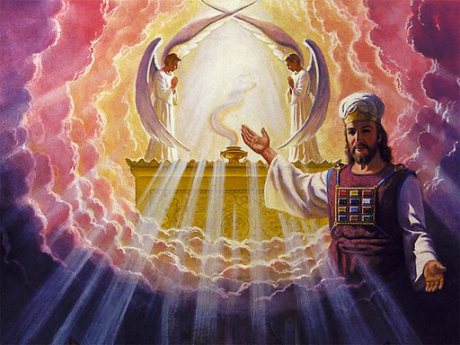
Jesus, as the Heavenly Priest of Melchizedek, also wearing the breastplate of Aaron. Also known as the “Urim and Thummim.” It is clear that Jesus is the “initiator” for the “Mysteries” of God in the Heavenly Temple.
Over at Temple Secrets, Tony Badillo explains that the animal sacrifice and its sacrificial blood represented a separation between the sins and a person’s spirit/soul:
On Ezekiel 44:6, 7 the Lord rebukes “rebellious” Israel for profaning his temple by offering him food in an unacceptable manner. What is his food? According to v. 7, “the fat and the blood;” similarly in v. 15 where only the Zadok priests may ”offer me the fat and the blood, says the Lord God”. There you have it! His “food” is blood and fat! Should we accept this literally? Yes, in the sense that blood and fat were literally offered to him. But No because he did not consume either. Why does he say this, then? Because the blood, actually poured outside into a Temple drain, symbolizes the spirit’s separation/expiation from sin; while the fat, when turned into smoke, symbolizes the spirit’s ascension to him for acceptance. God’s “food,” then, is simply the language of symbol, and it means that separation/expiation from sin (by the blood) and ascension of purified souls (the rising smoke) are the things he desires from people.
In John 6:53-56, Jesus says to his disciples:
Most assuredly, I say to you, unless you eat the flesh of the Son of Man and drink His blood, you have no life in you. Whoever eats My flesh and drinks My blood has eternal life, and I will raise him up at the last day. For My flesh is food indeed, and My blood is drink indeed. He who eats My flesh and drinks My blood abides in Me, and I in him.
Jesus implores his followers to consume his divine flesh and blood made up of spiritual light to regenerate their own fallen meat sacks degenerated as a result of Adam and Eve’s exile from Eden and from the consumption of the fruit of the knowledge of good and evil. Hence, the Holy Grail cup is said to contain the Christ’s saving blood of the Lamb—the remnant or leftover spiritual substance dripping from a primal trauma of a divine being, who is crucified by the rulers and authorities of the lower heavens, dies and resurrects so that his followers can follow his example, so that they might be salvaged from the sinfulness of the lower world/cosmos of the devil, which is destined to be overthrown, cast out and destroyed at the end of the apocalypse. The saved and elect are transferred into a new kingdom or reality of God while the rest who rejected the Gospel are destroyed.
Many of the Cathars believed what the mythicist scholar Earl Doherty theorizes was the earliest form of docetic Christology: that Christ was never incarnate on earth. Most of the radical dualist Cathars believed that the whole Jesus narrative, from the beginning of his ministry to his crucifixion, occurred in the heavenly world of the good god and in the astral realm of the demonic rulers.
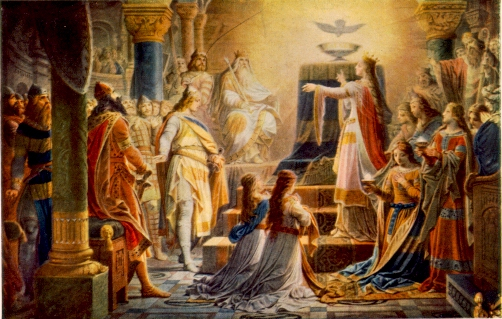
In the Parzival romance, the impotency of the Fisher King being his maimed, never-healing state (all thanks to Klingsor’s Spear) reflects the sterility of his land. It also reflects the nature of matter itself. In the studies of pagan practices by such scholars as Sir James G. Frazer in The Golden Bough: A Study in Magic and Religion, the recurring themes of the killing of the previous high priest or king to be replaced by a new avatar (much like John the Baptist and Jesus) and the marriage of fruitfulness of this new avatar with a female deity/queen is essential to the vegetative and natural fertility and prosperity of the land. The mirroring effect between the human enactment of natural prosperity and vice versa is apparent enough in the Priest-king of the Grail, Anfortas or the Fisher King’s “Waste Land” is to appropriate this mythic pagan belief into a solid representation that the barrenness of the soul/mind and body reflects upon the surroundings/ environment and nature. This, one might say is the objective co-relative function where the emotions, experiences of the subject becomes objective reality, hence the idea that the imaginal/spirit/ideal realm controls the realm of matter and the manifest world.
It is said that the blood of Christ at Holy Communion in Catholic ritual gives new life and deifies. But that blood is wine transfigured by the descending Holy Spirit in the form of a dove. However, this ritual does seem to have strong vampiric, witchcraft cannibalistic undertones, if placed in a literal context as the Catholic Church has done for hundreds, if not thousands of years. The Cathars were infamous for being hard, uncompromising opponents of the Catholic Sacrament as well as its icons and its worship of the Virgin Mary as devilish trickery to commit idolatry. Various Gnostic groups like the Phibionites, Barbelites, Bororites, Simonians, etc. as well as the Jews (and their rituals as magic in the form of “blood libel”) were accused of human and infant sacrifice in the form of ritually consuming fetuses, in the case that women became pregnant in their infamous orgies. In these ritual orgies, semen and menses were said to be also ritually consumed as a Eucharistic sacrament to Christ as Epiphanius claims in the Panarion. All of this seems to originate in Pliney the Elder in Natural History 30.11, when he writes as a matter-of-fact, that certain magical rites of the Magi (and Emperor Nero) involve ritually killing and eating men (e.g. cannibalism):
The Magi have certain means of evasion; for example that the gods neither obey those with freckles nor are seen by them. Was this perhaps their objection to Nero? But his body was without blemish; he was free to choose the fixed days, could easily obtain perfectly black sheep, and as for human sacrifice, he took the greatest delight in it.
So, in other words, could the Catholic Eucharist be just a Christianized magical ritual? We certainly see Romans who viewed the Christians as simply a diabolical secret society addicted to sorcery and the conjuring of daimons, as seen in Celsus in the True Doctrine and Suetonius in Nero 16.2. All of this seems to be a precursor for the Medieval and modern gossip and rumors of witch covens and Satanic elite secret societies, like the “Illuminati” who engage in human sacrifice and Faustian pacts with demons. The drinking of wine in Dionysian rituals involved ritually imbibing the spirit of Dionysus, which is like drinking the Elixir of Life, or “being baptized in wisdom.” The wine is the blood of the earth, “fruit of the vine and work of human hands.” This wine is used as a commemoration of ritually consuming the blood of Jesus. The Gospel of John chapter 2, where Jesus transmutes water into wine certainly plays on this distinctly Dionysian idea. So the outpouring of Christ’s blood on the cross is the outpouring of his very life—the spirit of the Son of God.

The Book of Hebrews (9:22-24) tells us that the blood of Jesus (and all the Old Testament sacrifices) were necessary in order to cleanse things in the heavens–the same place in which the angelic rebellion was said to have occurred as recorded in Revelation.
“And almost all things are by the law purged with blood; and without shedding of blood is no remission. It was therefore necessary that the patterns of things in the heavens should be cleansed with these; but the heavenly things themselves with better sacrifices than these. For Christ is not entered into the holy places made with hands, which are the figures of the true; but into heaven itself, now to appear in the presence of God for us.”
Colossians 1:20 says something very similar:
“And, having made peace through the blood of his cross, by him to reconcile all things unto himself; by him, I say, whether they be things in earth, or things in heaven.“
Notice how in Hebrews, it says that the tabernacle, and all its services, were “patterns of things in the heavens.” The physical objects associated with the earthly sanctuary were “figures of the true” — the “shadow of heavenly things” (Hebrews 8:5). As it follows, each physical item had its spiritual counterpart in heaven. So, as long as there was a tabernacle or temple on earth, there was a material reflection of God’s heavenly palace for mankind to see and take part in. This all sounds strangely reminiscent of certain Hermetic writings pertaining to “as above, so below.”
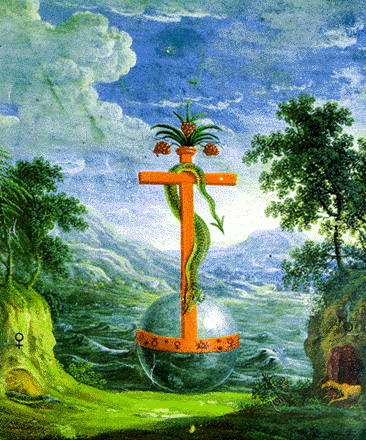
Also, in a way, when Jesus Christ was nailed to the Cross, he was essentially nailed to a circular “Leviathan” which is the same as the Ouroboros of the Gnostic alchemists like Mary the Jewess, Zosimos and the Ophites. The atheistic German philosopher Friedrich Nietzsche uses this symbolism to build his own theory of “eternal recurrence.” This is what the Gnostics called the “fall of spirit into matter.” Hence, we have various alchemical images of the crucified serpent, and perhaps even the same tempting serpent from Eden. According to the Apocryphon of John, there are a few archons that seem to have strong serpentine and dragon-like features, including Iao and Ialdabaoth, the chief archon and Gnostic parody of Jehovah. All of this seems to have a Pauline basis, in Colossians 2:13-15
…When you were dead in your transgressions and the uncircumcision of your flesh, He made you alive together with Him, having forgiven us all our transgressions, having canceled out the certificate of debt consisting of decrees against us, which was hostile to us; and He has taken it out of the way, having nailed it to the cross. When He had disarmed the rulers and authorities, He made a public display of them, having triumphed over them through Him.…
In the Gospel of Matthew (20:20-23), we read that a mother of Zebedee was asking Jesus to have her sons sit at his right and the other at his left hand in the Kingdom of God. Jesus asks her sons if they can drink what he is going to drink and they answer in the affirmative. Here is what Jesus says as a reply:
20 Then the mother of Zebedee’s sons came to Jesus with her sons and, kneeling down, asked a favor of him. 21 “What is it you want?” he asked. She said, “Grant that one of these two sons of mine may sit at your right and the other at your left in your kingdom.” 22 “You don’t know what you are asking,” Jesus said to them. “Can you drink the cup I am going to drink?” “We can,” they answered. 23 Jesus said to them, “You will indeed drink from my cup, but to sit at my right or left is not for me to grant. These places belong to those for whom they have been prepared by my Father.”
The Baptism of Blood and Water
In Genesis 1, the Spirit hovers over the face of the deep at the onset of creation. Water signifies the chaotic, untamed and unformed material of creation. It is the proto-element out of which all creation, the whole cosmos, including humanity, is ultimately made (Gen 1:2, 6; Ps 29:3) So crossing the waters of the great Flood, the waters of the Red Sea, the waters of the Jordan, and the waters of baptism are the recreating and renewing waters of creation. This water baptism acts like a conduit that transports the believer from one world (the old man of sin) to another (the newness in Christ). Likewise, priests must bathe in water before entering the Holy of Holies of the Temple of Solomon on the day of Atonement.
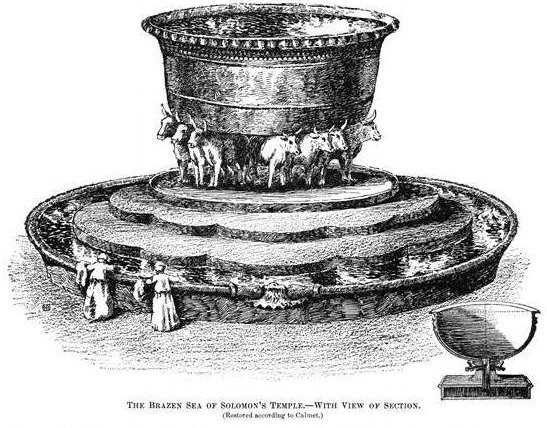
Similarly the Sea of Glass in Revelation 15:2, beside which those who have defeated the beast are standing, singing the song of Moses. This is a reflection of the “Molten Sea” which was a large basin in the Temple in Jerusalem made by Solomon for the ablution of the priests. It is described in 1 Kings 7 and 2 Chronicles 4. It stood in the southeastern corner of the inner court.
Water in essence is a unifying yet all-dissolving element of the earth and the cosmos. Blood and water together, therefore, signify the fullness of saved humanity: material body and animating soul and spirit as well as the sacrificed body and blood of the Lord Jesus Christ. In the Gospel of John 3:5, we have Jesus saying to Nicodemus “you must be born of water and the Spirit.” In 1 John 5:6, it says, “This is he who came by water and blood – Jesus Christ…there are three that testify: the Spirit and the water and the blood.”
We need to pause for a moment to reflect on this: the incarnated Son of God took on the likeness of humanity upon himself, meaning that this was not his original nature: this humanity, united to the Second Person of the Trinity, is literally poured out from his side upon the cross. This body and blood is NOT the same as the body and blood of communion, although they are clearly related. The bread and wine of Holy Communion are the substance and blood of the earth, transfigured by the Spirit of God to become our spiritual food and drink as the Eucharist.
The chalice in itself is not the real Holy Grail—that is simply romantic myth. The real Holy Grail is the very ground onto which this blood and water is sprinkled upon. The earth itself received the body and soul of Christ in his death. This is the blood and water of his sacrifice, rather than the blood and body of communion, although again, clearly the two are related. The bread and wine of communion—Christ’s body and blood—rather than being consumed by us to become part of our body, performs a spiritual function, transforming us into the body of Christ. “Though we are many, we are one body because we all share in the one bread.” Thus consuming Christ’s body and blood transforms us into itself. Likewise, with Christ’s blood and body out poured on the cross—it transforms the whole of creation into Christ’s body. Christ’s physical presence, although hidden, still abides throughout the very fabric of the universe. His humanity, which is our humanity, abides in creation, even today, transforming it and making it holy. In a sense, this relates to the infamous Baptism of Wisdom ritual of the Knights Templar in which we discuss in the book, at length.
Christ’s crucifixion and the Harrowing of Hell, in effect, unseated and usurped the power and possession of the authorities, archons and their demonic possession of the world and perhaps even the “Wasteland” of the Fisher King, a reflection of the inner state of the sinner. The quest for the holy grail to heal the wounded king and to restore the land to its original, pristine, Edenic state. Many see this as related to Matthew 4:19 in which Christ said, “Follow me, and I will make you fishers of men.” This reference would later become crucial to the Christian version of the Fisher King of the Arthurian Grail romances.
As one can see, the Parzival/Arthurian Grail stories, like the story of the Temple of Solomon is simply a retelling of Genesis (as well as a intricate visual depiction of the “Divine Man” or “Son of Man”), which in itself is a reflection of the war in heaven, and the fall of the angels. The Titanomachy of the Greeks as well as Hesiod’s Works (126) also speaks of similar tales of Olympian gods struggling against the titans and their terrible giant children, which no doubt mirror the infamous Nephilim of Genesis 6 and Enochian literature. Hesiod in the same text describes these Nephilim as being Heroes of the “Silver Race,” as a gigantic, brutal and ferocious giants:
Then, a second race, far inferior Was created, of Silver, by the gods…
Being reared by their mothers.
And when they reached adolescence,
They died a painful death,
On account of their stupidity,
For they could not contain their foolish pride and refused to worship the gods above and to sacrifice to them upon the altars.
Hesiod calls them “big children” (mega nepios) and tells how, disgusted with their impiety and arrogance, Zeus decided to wipe them off with a cataclysm, burying them in Tartarus, much like how Jehovah sends a flood to wipe the giant children of the Watchers and condemns the fallen angels in the abyss-like underworld in chains. Essentially all mythologies speak of similar wars between Blacks and Whites or between Angels and Devils, Devas and Asuras, Daevas, and Ahuras, the Sons of Light and the Sons of Darkness, Gods and Titans, etc., etc. This all seems to influence the story of Klingsor who injures the Fisher King with a spear. Klingsor also happens to be directly related with Faustus.
Once again, we cannot ignore Tony Badillo’s thoughtful explanation of Eden with those who are baptized in the Holy Spirit being the Spirit of God, which have strong Gnostic undertones:
…in Isaiah 58:11 and Jeremiah 31:12 the people themselves are a “well watered garden,” implying that Paradise on earth consists of an ideal relationship between God and humans. This is a key reason why the Divine spirit is not given solely or primarily for uttering profound prophecies, performing marvelous miracles, or making doomsday declarations, but for subduing the Sinful Inclination and renewing God’s “image and likeness” within each of us, and in so doing we become like a well watered garden, Genesis 2:10, bearing good fruit for the one who did the planting. This is the true Paradise, the true Garden of Eden while we are here on earth. And that which waters one’s personal garden is the Divine spirit.
The sprinkling of his blood on the earth, prefigured in the Old Testament by the sprinkling of the blood of the sacrificial bull and goat in the Holy of Holies, has made the world the Holy of Holies, the dwelling place of God, signified by the rending of the veil in the Temple. Yet it remains hidden, invisible, and unknown, until the day that the new heaven and new earth are revealed when Christ returns again in glory as discussed in Matthew and Revelation. Just like the hiddenness of the glory of God, momentarily revealed in the burning bush, or on the Mount of Transfiguration. On that day we will see that “in him we live and move and have our being.” The sacrificial bull concept, however, is an ancient Rome and eventually later from Mithraic sacrificial rites. The Gospel of John tells us that after the death and resurrection of Jesus, the Baptism of the Holy Spirit is made manifest to the believer, and the Body of Christ.
According to the Excerpts of Theodotus, the Valentinian teacher Theodotus said that the baptism releases the believer from the clutches of passions, Fate, destiny, and demonic powers that infest the lower world in which mankind finds himself exiled in.
76 As, therefore, the birth of the Saviour released us from “becoming” and from Fate, so also his baptism rescued us from fire, and his Passion rescued us from passion in order that we might in all things follow him. For he who was baptised unto God advanced toward God and has received “power to walk upon scorpions and snakes,” the evil powers. And he commands the disciples “When ye go about, preach and them that believe baptise in the name of the Father, and of the Son and of the Holy Spirit,” in whom we are born again, becoming higher than all the other powers.
77 Therefore baptism is called death and an end of the old life when we take leave of the evil principalities, but it is also called life according to Christ, of which he is sole Lord. But the power of the transformation of him who is baptised does not concern the body but the soul, for he who comes up [out of the water] is unchanged. From the moment when he comes up from baptism he is called a servant of God even by the unclean spirits and they now “tremble” at him whom shortly before they obsessed.
78 Until baptism, they say, Fate is real, but after it the astrologists are no longer right. But it is not only the washing that is liberating, but the knowledge of/who we were, and what we have become, where we were or where we were placed, whither we hasten, from what we are redeemed, what birth is and what rebirth.
The Foundation Stone of Fallen Angels
The holy grail also has a strong Hermetic ring to it as Tracy and I have explored in depth in our book. We point out that the word “grail” itself has been derived from crater, the Greco-Latin term for a vessel, meaning a shallow vessel or plate where sacrifices were offered to the gods in ancient Greece. We also explore in depth how the Holy Grail concept is directly tied with the Corpus Hermeticum, as well as Wolfram’s Parzival, which is in itself almost a paraphrase of the Hermetica- a collection of ancient Egyptian texts that also reflect the Gnosticizing tendencies of Alexandria, Egypt. Wolfram rewrote it to match it with thirteenth-century German sensibility. The Holy Grail themes seem to greatly match with the Krater of the Hermetica which directly mirror Parzival’s spiritual journey. In fact, as the above link quotes a book called The Krater and the Grail: Hermetic Sources of the Parzival by Henry and Renee Kahane as towards the end of Parzival, they compare the precision of knights in the Grail Castle to the universe and the Holy Grail itself to the Monad as I.M. Oderberg writes:
A procession comprising the knights and the twenty-four maidens attending the Grail entered the hall, only Repanse de Schoie being permitted by the sacred object to be its bearer. These attendants were grouped in numbers, first four, then eight, then twelve divided into two sixes. Each group carried corresponding numbers of lights. Last came the “princess” of the Grail carrying one. This sequence has baffled many commentators, but Kahane and Kahane point out the marked similarity with the Hermetica, where the groups in the same order “represent the twenty-four stations of the journey of the soul: 4 elements + 8 spheres + 12 signs of the zodiac + 1, the Monad. . . . The Grail procession, in other words, is a representation of the mystic journey of the soul towards the Monad, itself symbolized by the Grail” (op. cit., pp. 105-6).
The end of the Grail quest is the return to the source of life and rebirth into it as divinely self-conscious entities purified by involvement in earthly experiences and having also contributed to the ongoing process of cosmic evolution by refining the substance they have used. The great lesson for Parzival — for all of us because he is our prototype — was the interconnected relationship of all earth entities. The bonds of a universal brotherhood make us all kin. The suffering of one hurts all, and compassion in our heart obliges us to ask forever: What ails our brother?
What could be the most interesting aspect of this story, involves looking at the second clue of what the Holy Grail represents, provided by Wolfram in the form of “a precious stone, lapsit exillis (i.e. lapis or lapsi ex caelis) of special purity, possessing miraculous powers conferred upon it and sustained by a consecrated Host”, which is indeed the blood of Christ, with holy powers to act as the Elixir of Life. This precious stone fallen from heaven is both the emerald fallen from Lucifer’s crown.
Wolfram von Eschenbach identified the Holy Grail as a Stone of Heaven, he knew he was alluding to a Holy Grail tradition that had extended far back into the mists of time. Many traditions tell that primitive man, experienced a physical and or emotional change just by being in proximity to certain stones. Even the term “magic,” associated with the title of “Magus” or “magician” has its etymological roots in the force of magnets or magnetism, which plays into the idea of “greatness,” or “magnifying” one’s spirit or essential self under the light of God. Perhaps this is why Simon was called “Megas” Greek for “Great” which sounds virtually the same as “Magus.” The Persians thought of their priests as “magos” as well.
Alchemists told of transforming a base metal into gold and a human into a god or goddess. Many texts were cataloged of the Muslim Empire by the Sufis, who added their own alchemical data before transmitting it to their students, the Knights Templar, who took the wisdom into Europe and supposedly carried in tradition through Freemasonry. Those indoctrinated were of the Holy grail Mysteries and eventually given the wisdom of the Alchemical or Philosophers Stone. Some tell of it being a platter or bowl full of precious stones. The Stone of Heaven is a Latin translation of the term Lapsit Exillus, closely related to Lapis Elixir, an appellation used by the Sufis that denoted, “Philosopher’s Stone.” Lapsit derived from “stone” and related to the Latin lapsus, meaning fallen, thus denoting “fallen stone.” Since the term Exillus is related to exillis stellis, meaning : “from the stars,” the entire moniker Lapsit Exillus literally translates as “The Stone of the Heavens” or “The Stone which came down from the Stars.”
The name Stone of Heaven can also be derived from the word Grail. The term Grail is derived from the French gres or Persian gohr, both denoting a stone. The Grail of Greal could also be related to the French grele, meaning hailstone, which is a “stone” from heaven. According to Arthur Edward Waite, the term Lapsit Exillus is “Exiles Stone.” This surprisingly affiliates the Stone of heaven with Heaven’s most notorious exile, Lucifer. A poem of a German heritage called, Wartburgkrieg, the “Wartburg War,” summarizes the heavenly battle between Lucifer and St. Michael, and identifies the Stone of Heaven as a large emerald that became dislodged from Lucifer’s crown and descended to Earth:
“Shall I then bring the crown
That was made by 60,000 angels?ill
Who wished to force GOD out of the Kingdom of Heaven.
See! Lucifer, there he is!
If there are master-priests,
Then you know well that I am singing the truth.
Saint Michael saw GOD’s anger, plagued by His insolence.
He took (Lucifer’s) crown from his head,
In such a way that a stone jumped out of it.
Which on Earth became Parsifal’s stone.
The stone which sprang out of it,
He found it, he who struggled for honor at such a high cost.”
Lucifer’s fall that is incorporated into this poem first popularized by the Prophet Isaiah during his harangue against the King of Babylon. When describing the decline and all of the King of Babylon, Isaiah used the metaphor of the Morning star’s “fall” or descent below the horizon at sunrise, an image subsequently became linked to Lucifer when translated into Latin was Luz-I-fer or Lucifer, the Light Bringer. Morning Star then became known as Shahar or Helel, which were the names of Venus’ dawn appearance. Thus, Lucifer is associated with both Venus and Helel, a name that evolved into Hell, Lucifer’s underworld home.
In the Book of Ezekiel, he expanded upon the meaning of Lucifer’s infamous fall. While comparing the King of Tyre with Lucifer, Ezekiel identifies Lucifer as the anointed cherub and forever-young boy who once walked in the Garden of Eden while covered in precious stones, including the emerald, and was perfect in his ways and from that day he was created until iniquity was found in him. Thus Ezekiel perpetuated the tradition of Isaiah by making Lucifer’s fall the product of pride.
Ezekiel 28:13 tells us:
You were in Eden, the garden of God; every precious stone adorned you: carnelian, chrysolite and emerald, topaz, onyx and jasper, lapis lazuli, turquoise and beryl. Your settings and mountings were made of gold; on the day you were created they were prepared.
Lucifer then resolves to rule in Heaven and this culminated in his expulsion from Paradise. When St. Michael and his angels fought with Lucifer/Samael over his right to rule, states John the Revelator, “that old serpent, called the devil, and Satan which deceiveth the whole world…was cast out (of heaven) into the earth, and his angels were cast with him.”
The remainder of Lucifer’s legend in the poem states that during the battle with Michael, an emerald became dislodged from Lucifer’s crown and fell to Earth. This is based on Ezekiel’s description of the gems-especially the emerald-that adorned Lucifer’s regalia in the Garden of Eden. It is also influenced by the Knights Templar. But of course this predates the Templar’s by many thousand of years. Before their time the emerald had been recognized as the esteemed Stone of Venus, the “fallen star” of Lucifer.
Strangely enough, however, Lucifer does seem to embody the twin archetype we see over and over in world mythologies. In a way, Michael the archangel could also very well be his angelic twin, just as Metatron is said to have an angelic twin soul in the form of Sandalphon. Both of these angels’ lower selves exist in the forms of both Enoch and Elijah, both of which are intimately connected with Hermes Trismegistus. In Roman myths, we have Romulus and Remus, in Genesis, Cain and Abel, Ariman and Angra Manyu in Persia, the Ashvin Twins, or Mitra and Varuna in India; Zeus and Poseidon, Castor and Pollux, Apollo and Dionysus and Hercules and Atlas in Greece; Set-Typhon and Horus in Egypt, etc. In a way, Lucifer is simply a reflection of the Supreme Heavenly Father, who is the spiritual sun of Heaven.
As the story goes, a number of angels remained neutral and inactive during the battle of Lucifer and the rebel angels against God and the faithful heavenly hosts, after Lucifer’s fall they were condemned by God to support this stone, which had dropped from Lucifer’s crown, hovering between Heaven and Earth until the hour of the redemption of sinful mankind and the “Day of Judgement” at the end of the apocalypse. Then they brought it to Earth, and, formed into a holy vessel, it served for the dish out of which the Jews ate the Paschal lamb in Exodus 12 on Passover, and in which Joseph of Arimathea received the Saviour’s blood, and perhaps even the receptacle for the severed head of John the Baptist.
By uniting the two objects, being the kraters and with meteoritic stones fallen from heaven, it becomes obvious. We see ancient worship of meteorites in the Kaaba Stone of Mecca in Saudia Arabia, which is associated with the worship of Venus/Lucifer and Saturn/Chronos, the pyramids of Mexico, the vajra thunderbolt of Hinduism, etc. So the Grail is indeed the meteorite crater opened up by a falling object from the heavens. It may also refer to volcanic activity and magma, associated with the conflagration spoken by the ancients that is said to have destroyed Atlantis-Eden.
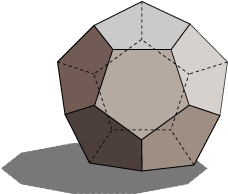
Rudolf Steiner, the Austrian philosopher and esotericist famously reimagined the grail, foundation stone as a, “dodecahedron fashioned in copper in 1913 to consecrate the building called the first Goetheanum, with twelve, pentagonal (five-sided) facets and called the “dodecahedron of man.” (Bill Trusiewicz, The Foundation Stone as The Golden Triangle, The Mystic Hammer, and The Lost Word)
Bill Trusiewiscz further asks:
Firstly, we should ask: What is a foundation stone? Also called a “cornerstone,” a foundation stone is a stone ceremoniously set in place at the start of the construction of a building. This is done to initiate certain defining principles or ideas in connection with the proposed building with the intention of consecrating it for a specific purpose. It is, if you will, a “mental” building to use modern terminology, to correspond to a physical building proposed. Students of spiritual science would likely be comfortable with the idea that the “soul and spirit” foundations of the building were being laid alongside of the sense perceptible building itself.
Indeed, the Foundation Stone concept can be found all throughout the Old Testament and in the Jewish apocrypha, especially in 2 Enoch (see my paper “The Gods of Imagination: Alchemy, Magic, and the Quintessence” found in The Gnostic 6 by Andrew Phillip Smith). It is the starting point or even the “heart” in which the world and even the whole breadth of the cosmos is founded upon. It is also the Holy of Holies, in which it becomes the “cornerstone” of the Temple of Solomon, which is just another form of the Grail Temple of Parzival. Perhaps this is where the Theosophists would claim that Shamballah of Tibet would be the “heart of the earth” and the “King of the Earth” being “Sanat Kumara,” the so-called “Lord of the Flame” came from Venus! This is undoubtedly connected to Lucifer, the equivalent of Rex Mundi of the Cathars, Melek Taus of the Yezidis, Satan “the god of this world/cosmos” to St. Paul and Ialdabaoth and his legions of archons to the Gnostics. As it follows, the foundation stone is currently owned by Lucifer on his crown, since he is essentially the “prince of the world,” as the Fourth Gospel puts it, when he fell into the depths of the sub-lunar realm after the War in Heaven.

In The Creation and the Garden of Eden as Models for Temple Architecture by Jeffrey M. Bradshaw, he quotes from a not-so-easily identifiable source but it is worth quoting nonetheless:
The brightness of the Holy of Holies was the light of Day One, before the visible world had been created… Those who entered the Holy of Holies entered this place of light, beyond time and matter, which was the presence of “the King of kings and Lord of lords who alone has immortality and dwells in unapproachable light.” This was the place of glory to which Jesus knew he would return after the crucifixion, “the glory which I had with thee before the world was made.” In the Gospel of Thomas, Christians are described as the new high priesthood who enter the light, and Jesus instructed his disciples to say to the guardians (the cherub guardians of Eden?) “We came from the light, the place where the light came into being on its own accord and established [itself]…
Bradshaw rightly points out that the tabernacle of Moses is an earthly attempt to recapture the Edenic state that that man once held before the fall:
Carrying this idea forward to a later epoch, Exodus 40:33 describes how Moses completed the tabernacle. The Hebrew text exactly parallels the account of how God finished creation. Genesis Rabbah comments: “It is as if, on that day [i.e., the day the tabernacle was raised in the wilderness], I actually created the world.” With this idea in mind, Hugh Nibley has famously called the temple “a scale-model of the universe.” As a complement to the view of the Creation as a model for the temple, BYU Professor Donald W. Parry has argued that the Garden of Eden can be seen as a natural “temple,” where Adam and Eve lived in God’s presence for a time, and mirroring the configuration of the heavenly temple intended as their ultimate destination.
Bradshaw concludes that the temple symbolism of Revelation also carries on this Edenic/Solomonic tradition:
Fittingly, just as the first book of the Bible, Genesis, recounts the story of Adam and Eve being cast out from the Garden, its last book, Revelation, prophesies a permanent return to Eden for the sanctified.36 In that day, the veil that separates man and the rest of fallen creation from God will be swept away, and all shall be “done in earth, as it is in heaven.”37 In the original Garden of Eden, “there was no need for a temple—because Adam and Eve enjoyed the continual presence of God”—likewise, in John’s vision “there was no temple in the Holy City, ‘for its temple is the Lord God.’”38 To reenter the Garden at that happy day is to return to the original spiritual state of immortality and innocence through forgiveness of sin, and to know the oneness that existed at the dawn of Creation, before the creative processes of division and separation began. The premortal glory of the righteous shall then be “added upon” 39 as they receive a fullness of the blessings of sanctification, “coupled with eternal glory, which glory we do not now enjoy.”
The Even ha’Shettiya, also known as the “Stone of Foundation,” which currently resides within the eight-sided Dome of the Rock in Jerusalem, the Holy City and center and heart of the earth as European mapmakers charted.
This is the same rock that supposedly was the same rocky site upon which Abraham was coerced into sacrificing his own son Isaac in the sight of Jehovah, to test his faith, as well as the place where Mohammed was lifted into Heaven by the archangel Gabriel. This is also the same site where the Knights Templar resided nearby when they founded modern-day Jerusalem. So the Stone of Foundation for the Jews, Muslims, and the Catholic Crusaders was in fact, the Stone of Lucifer as part of the Axis Mundi or column that unites Heaven and Earth, and even the Underworld. King David, who purchased the rock of the Even ha’Shetityya from the Jebusites as the location of the Ark of the Covenant, was not overlooked by him. This sacred object primarily served as a vehicle for communication with Jehovah/Yahweh.

King Solomon holding the Grail Temple and Royal Scepter.
David’s son, King Solomon, a famous alchemist, similarly thought that the stone’s alchemical properties as a mediator between Heaven and Earth, used the rock as a cornerstone or foundation for his famous Temple, which would draw upon the power and spirit of YHWH. We see the Testament of Solomon depicting Sabaoth as the god of Solomon, who gives him a magical ring through the archangel Michael to build the temple through the forced help of 72 goetic demon helpers. This is Sabaoth is probably the same deity as Abraxas. (This connection is fully explored further in depth in the book.)
Perhaps the pyramids of Egypt and Mexico were constructed by similar means through the use of demonic, supernatural power. Furthermore, perhaps this is what the Knights Templar were so drawn towards—the supernatural power behind the Temple of Solomon—the same power that would one day make them so rich that they would become a threat to French and Catholic nobility. It is this power that manifest itself in the form of a head of a man or even of a cat, and eventually from the Dionysian and Azazel-like goat head.
What is most fascinating as that the Freemasonic pontiff Albert Pike in Morals & Dogma seems to spur and condemn the idea that the Templars also worshiped Baphomet when he writes:
“[It is absurd to suppose that men of intellect adored a monstrous idol called Baphomet, or recognized Mahomet as an inspired prophet. Their symbolism, invented ages before, to conceal what it was dangerous to avow, was of course misunderstood by those who were not adepts, and to their enemies seemed to be pantheistic. The calf of gold, made by Aaron for the Israelites, was but one of the oxen under the laver of bronze, and the Karobim on the Propitiatory, misunderstood. The symbols of the wise always become the idols of the ignorant multitude. What the Chiefs of the Order really believed and taught, is indicated to the Adepts by the hints contained in the high Degrees of Free-Masonry, and by the symbols which only the Adepts understand.“
Pike is claiming that the symbolism associated with the Templars and Freemasonry is veiled and misunderstood by the masses also reflects the idea that the alchemical Philosopher’s Stone was simply a ruse created by alchemists to confuse the masses and mask their true and secret methods and sciences to create gold or something else completely. However, this doesn’t answer the general claim that a certain Templar possessed a severed idol head and turned to it to form their own Faustian pact with the spirit of Baphomet. We can gain more clarity on this subject from Sean Martin in The Knights Templar (p. 139):
Misunderstanding is almost certainly at the root of the allegation that the Templars worshipped an idol called Baphomet. Descriptions of it varied, but it was usually described as being a life-sized head, which was said to make the land fertile (as is said of the Grail). That the Templars did possess heads is without doubt. They possessed the head of St Euphemia of Chalcedon at their preceptory in Nicosia on Cyprus, and, more curiously, a silver head shaped reliquary was found after the arrests at the Paris Temple. This bore the inscription CAPUT LVIII, and inside it were parts of a woman’s skull (who was believed to have been one of the 11,000 virgins martyred at Cologne with St Ursula). The heads may have indeed been worshiped, in the way that the Celts revered the head.
The Assassins, during their initiation ceremonies, buried the initiate up to his neck in sand, leaving only the head visible, before disinterring him. Given their simulation of Saracen torture, the Templars may also have carried out this practice. A further possibility is that Baphomet, long thought to be a mistranslation of ‘Mahomet’ (the Prophet Muhammad), could well be a corruption of the Arabic word abufihamat, which means ‘Father of Understanding’, a reference to a spiritual seeker after realization or enlightenment has taken place: ‘The Baphomet is none other than the symbol of the completed man.’44 It is therefore possible that the supposed head the Templars worshipped was actually a metaphorical head. That Hugues de Payen’s shield carried three black heads suggests that certain elements within the Order – the upper echelons perhaps – were involved with esoteric disciplines learned from the Sufis from the very beginning of the Temple’s existence.
Could these “alchemical heads” be code words for a secret knowledge held by the minds of the initiated as well as literal severed heads who supposedly “prophesied”? The Templars were also said to have in their possession, ritual skulls made out of precious metals and human bone covered in gold and silver. These skulls may have been their own deceased brethren. There are testimonies taken from the Catholic inquisitions that purport of the Templars alluding to possessing metallic skulls used in Templar ceremonies, especially in the legend of The Necromantic Skull Of Sidon.
Skulls tend to be used in ancestor worship and also happen to be the premiere emblem of Mexican commemoration of the Dia de los Muertos (“Day of the Dead” being a pre-Colombian tradition of ancestor worship and colonial Catholicism) and demonic deity of the drug cartels, Santa Muerte, a mixture of the Virgin Mary (who, herself is the Catholic version of Astarte and Ishtar/Lilith) and the Aztec god of death Mictlantecuhtli. The Yale Masonic secret society of the “Skull & Bones,” a Satanic club of which a string of U.S. Presidents belong to (John Kerry, the Bush family, etc.) via secret oaths and initiation rites into diabolism similar to the ones found in Templar Baphometic rites. These “Bonesmen” have their origins in the so-called “Bavarian Illuminati” who themselves come from the Jesuits, whose saints are often depicted next to skulls or holding skulls. There are paintings depicting Mary Magdalene holding a skull as well.

The famous skull and crossbones motif normally associated with pirates is often said to have originated with this skull from Sidon, but it was probably much older. This haunting motif, which we today associate with poison, was most likely a symbol related to the earlier alchemical rites of the Templar Knights. During these early rites, skulls were used representing “Caput Mortumm” or “Dead Head,” which refers to a stage in alchemy preceding creation of the “Philosophers Stone,” which is the Great Work of the alchemists, equated with spiritualized gold. This is the stage of “Nigredo” or the “blackening” in Hades/Hell. The Gnostic-Hermetist Zosimos depicts this stage in the most extreme and gruesome imagery in his alchemical work Visions.
The most important skull or head used in the rites of the Knights Templar was known within the Order as Baphomet. This most sacred of heads, which many of the Knights alluded to during their depositions preceding their French trial, may have been that of John the Baptist, whose head was acquired by the Templar’s as part of treasure they looted from Constantinople during the Fourth Crusade in the 11th century. Even stranger is the fact that this Baphomet skull could also be related to the head of Simon Magus–one of the bad guys featured in the Book of Acts.
However, the idea that the Templars revered Baphomet in its Gnosticized form, seems to be a later additional detail that emerges during the French Revolution and was later emphasized by the likes of Purgstall, Eliphas Levi, Aleister Crowley, etc. Whatever the case may be, it seems as though the Templar treasure is somehow tied with the symbolism of the head, the mind, as well as the Holy Grail cup which is associated with drinking the wisdom of various Hermetic and Gnostic deities and alchemists like Zosimos, as we explain in the book. Indeed, even the Holy Grail/Fisher King legends themselves have strong associations with Gnosticism, and it is this heresy that Roman Catholicism greatly desired to have stamped out of existence and absorbed into their own “universal” collective religion.
